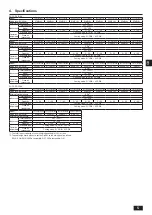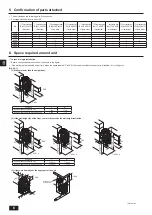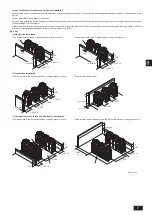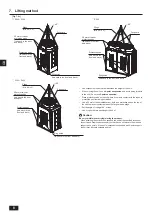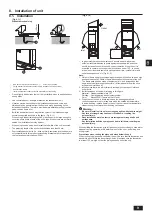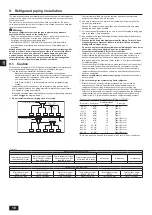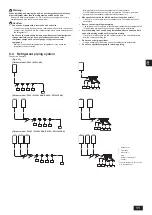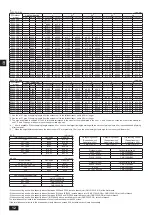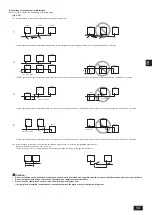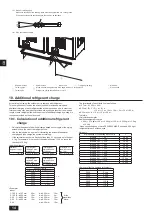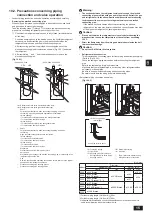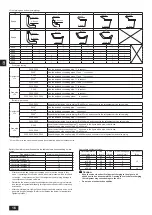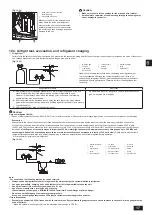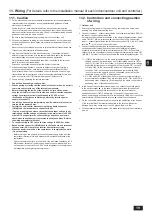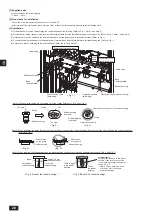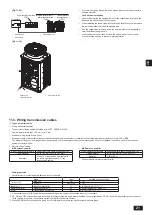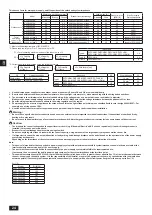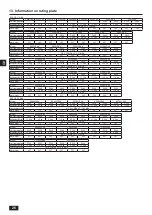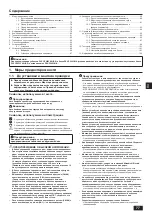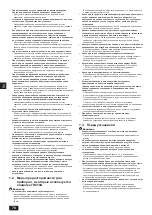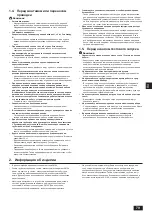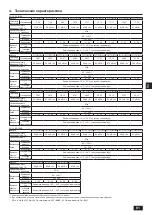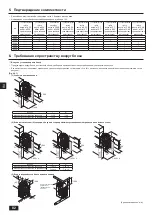
19
GB
11.1. Caution
1
Follow ordinance of your governmental organization for technical standard
related to electrical equipment, wiring regulations and guidance of each
electric power company.
2
Wiring for control (hereinafter referred to as transmission line) shall be
(5 cm or more) apart from power source wiring so that it is not influenced by
electric noise from power source wiring. (Do not insert transmission line and
power source wire in the same conduit.)
3
Be sure to provide designated grounding work to the outdoor unit.
4
Give some allowance to wiring for the electrical part box on the indoor and
outdoor units, because these boxes are sometimes removed at the time of
service work.
5
Never connect the main power source to terminal block of transmission line.
If connected, electrical parts will be damaged.
6
Use 2-core shield cable for the transmission line. If transmission lines of
different systems are wired with the same multiplecore cable, the resultant
poor transmitting and receiving will cause erroneous operations.
7
Only the transmission line specified should be connected to the terminal
block for outdoor unit transmission.
Erroneous connection does not allow the system to operate.
8
When connecting a System Controller to outdoor units or performing a
group operation of indoor units that are connected to different outdoor
units, a transmission line for centralized control is required. When using a
transmission line for centralized control, connect the transmission line (non-
polar 2 core wire) to all TB7 terminals between all outdoor units.
9
Group is set by operating the remote controller.
• Control box houses high-voltage parts.
• When opening or closing the front panel of the control box, do not let it
come into contact with any of the internal components.
• Before inspecting the inside of the control box, turn off the power,
keep the unit off for at least 10 minutes, and confirm that the capacitor
voltage (inverter main circuit) has dropped to 20 VDC or less.
(It takes about 10 minutes to discharge electricity after the power
supply is turned off.)
• Control box houses high temperature parts. Be well careful even after
turning off the power source.
• Perform the service after disconnecting the fan board connector
(CNINV) and the inverter board connector (CN1).
(To plug or unplug connectors, check that the outdoor unit fan is not
rotating and that the voltage of capacitor in the main circuit is 20 VDC
or below. The capacitor may collect a charge and cause an electric
shock when the outdoor unit fan rotates in windy conditions. Refer to
the wiring nameplate for details.)
• To connect wiring to TB7, check that the voltage is 20 VDC or below.
• Reconnect the connector (CNINV) back to the fan board and reconnect
the connector (CN1) back to the inverter board after servicing.
• When the power is turned on, the compressor is energized even while
it is not operating.
- Before turning on the power, disconnect all power supply wires from the
compressor terminal block, and measure the insulation resistance of the
compressor.
- Check the compressor for a ground fault. If the insulation resistance is 1.0
MΩ or below, connect all power supply wires to the compressor and turn
on the power to the outdoor unit. (The liquid refrigerant in the compressor
will evaporate by energizing the compressor.)
11. Wiring
(For details, refer to the installation manual of each indoor/outdoor unit and controller.)
11.2. Control box and connecting position
of wiring
1
Outdoor unit
1. Remove the front panel of the control box by removing the 4 screws and
pushing it up a little before pulling it out.
2. Connect the indoor - outdoor transmission line to the terminal block (TB3) for
the indoor - outdoor transmission line.
If multiple outdoor units are connected in the same refrigerant system, daisy-
chain TB3 (M1, M2, earth terminal ) on the outdoor units. Connect the
indoor - outdoor transmission line for the outdoor units to TB3 (M1, M2, earth
terminal ) of only one of the outdoor units.
3. Connect the transmission lines for centralized control (between the
centralized control system and the outdoor unit of different refrigerant
systems) to the terminal block for centralized control (TB7). If the multiple
outdoor units are connected to the same refrigerant system, daisy-chain TB7
(M1, M2, S Terminal) on the outdoor units in the same refrigerant system. (*1)
*1 : If TB7 on the outdoor unit in the same refrigerant system is not daisy-
chained, connect the transmission line for centralized control to TB7 on
the OC (*2). If the OC is out of order, or if the centralized control is being
conducted during the power supply shut-off, daisy-chain TB7 on the OC,
OS1 and OS2. (In the case that the outdoor unit whose power supply
connector CN41 on the control board has been replaced with CN40
is out of order or the power is shut-off, centralized control will not be
conducted even when TB7 is daisy-chained.)
*2 : OC, OS1 and OS2 of the outdoor units in the same refrigerant system
are automatically identified. They are identified as OC, OS1 and OS2 in
descending order of capacity. (If the capacity is the same, they will be in
ascending order of their address number.)
4. In the case of indoor-outdoor transmission line, connect the shield ground
to the earth terminal . In the case of transmission lines for centralized
control, connect it to the shield terminal (S) on the terminal block for
centralized control (TB7). Furthermore, in the case of the outdoor units
whose power supply connector CN41 is replaced with CN40, short circuit the
shield terminal (S) and the earth terminal in addition to the above.
5. Fix the connected wires securely in place with the cable strap at the bottom
of the terminal block. External force applied to the terminal block may
damage it and may cause a short circuit, ground fault, or a fire.
6. When extending the transmission line, make sure to extend the shield cable
as well.

